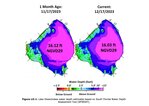As predicted, so far the “dry” season has brought above average rainfall, keeping Lake Okeechobee near 16 feet
Join our family of readers for as little as $5 per month and support local, unbiased journalism.
Already have an account? Log in to continue. Otherwise, follow the link below to join.
Please log in to continue |


As predicted, so far the “dry” season has brought above average rainfall, keeping Lake Okeechobee near 16 feet above sea level.
The week of Dec. 11-17 (the last South Florida Water Management District Environmental Report available due to the holidays) Lake Okeechobee received 52,980 acre feet of water in direct rainfall while only 14,680 acre feet left the lake through evapotranspiration (a combination of evaporation and plant transpiration.) Flow to the west to the Caloosahatchee is limited to 2,000 cubic feet per second (cfs), measured at the Franklin Lock. This flow, which is in the beneficial range for the estuary salinity, includes local basin runoff. So if there is rainfall in the basin, less water is released from Lake Okeechobee. No water was released east to the St. Lucie Canal. Flow south depends on rainfall south. That same week, direct rainfall to the water conservation areas (WCAs) south of the lake totaled 103,730 acre feet. Due to the heavy rainfall south of the Big O, there was little capacity to move water south.
On Dec. 28, the big lake was at 15.97 feet.
Levels above 15.5 feet are damaging to the lake’s ecology. At 15.5 feet, the marshes around the lake edge are inundated with water. As the water level rises, the water stacks up against the sides of the Herbert Hoover Dike.
Starting the new year with the lake level so high also means there is little chance the lake will get low enough for new submerged aquatic vegetation (SAV) to grow. The lake needs water levels below 12 feet in order for sunlight to reach the lake bottom, causing SAV seeds to germinate. Once the seeds germinate, if the water levels rise faster than the plants can grow, the new SAV may be damaged or lost.
Mother Nature intended the lake level to rise very slowly during the wet season, but the flood control system changed the natural flow. According to the U.S. Geological Survey, before the Central and South Florida (C&SF) Flood Control Project, rain that fell in the Kissimmee/Orlando area took about six months to slowly sheet flow south, spreading out over thousands of acres of floodplain. Along the way, the water was cleaned by vegetation. During that time, some of the water percolated into the earth; some water evaporated into the air.
Thanks to the canal system that provides flood protection to the urban areas, rain that falls at the top of the historic Everglades (near Orlando) is now quickly funneled into the Kissimmee River. As evidenced by the billions of gallons of flood water were pumped down the river to relieve flooding in Orlando after Hurricane Ian – pushing the lake level up several feet in a matter of weeks -- the “restoration” of the center third of the Kissimmee River did not significantly slow the flow after a storm.
While most of the rain that falls on ranches and farms percolates into the earth, rain that falls on streets, buildings and other impervious surfaces runs off quickly. As ranchland or farmland is lost to development, the volume of runoff increases.